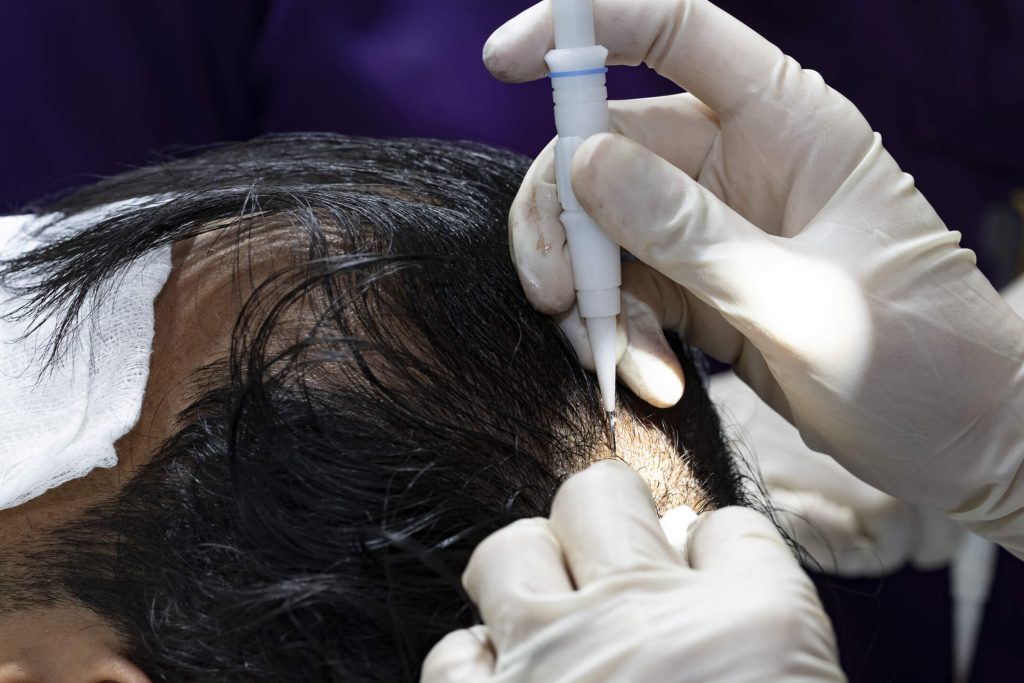Hair loss is a common concern for many individuals, prompting them to explore various hair restoration options. Among the popular choices are NeoGraft and Follicular Unit Extraction (FUE), two innovative techniques revolutionizing the field of hair transplantation. In this blog, we’ll delve into the key differences between NeoGraft and FUE, shedding light on their benefits, risks, advantages, disadvantages, and helping you make an informed decision for your hair restoration journey.
Hair Transplant Basics
Hair transplant surgery is a cosmetic procedure to treat baldness and restore a natural hairline. One common method is Follicular Unit Extraction (FUE), where individual hair grafts are manually taken from the back of the donor area’s scalp and implanted in areas with hair loss. Another advanced approach is the NeoGraft system, an automated version of FUE utilizing specialized technology for precise extraction and transplantation. NeoGraft is minimally invasive, reducing scarring, while the FUE technique yields natural results without a linear scar. The choice between these methods depends on factors such as cost, recovery time, and the expertise of healthcare professionals.
Both FUE and NeoGraft have their pros and cons for hair transplant. FUE, using the ARTAS tool, is known for its versatility and natural outcomes but may require more effort and a skilled surgeon. NeoGraft, employing automated technology, offers precision and a quicker hair restoration procedure but comes with a higher hair transplant cost. Individuals contemplating a hair transplant should consult with a specialist to choose the most suitable method based on preferences, budget, and desired results. Whether opting for manual finesse or automated precision, these modern hair transplant methods provide effective solutions for people seeking to address hair loss and enhance their confidence.
Comparison Between NeoGraft vs FUE
When considering hair transplantation, two popular methods that often come into the spotlight are NeoGraft and Follicular Unit Extraction (FUE). Both approaches are designed to address hair loss and provide natural-looking results, but their hair restoration techniques and technology differ.
NeoGraft
NeoGraft is an advanced hair transplant technology that automates the FUE procedure. FUE involves extracting individual hair follicles directly from the donor area (usually the back of the scalp) without requiring a linear incision. NeoGraft utilizes a specialized hair transplant device to harvest and transplant hair follicles, enhancing precision and efficiency.
Advantages of NeoGraft
1. Minimally Invasive – NeoGraft is less invasive compared to traditional hair transplant methods, reducing scarring and downtime for patients.
2. Automated Precision – The automated extraction and hair transplantation process of NeoGraft enhance precision and minimize the risk of human error, ensuring a more consistent outcome.
3. Faster Procedure – NeoGraft typically allows for a faster procedure compared to manual FUE process, resulting in shorter overall surgery time.
Disadvantages of NeoGraft
1. Cost – NeoGraft procedures tend to be more expensive than traditional FUE method due to the advanced technology involved.
2. Learning Curve – Training and experience are crucial for healthcare professionals using NeoGraft, as the technology requires a learning curve to achieve optimal results.
FUE (Follicular Unit Extraction)
FUE is a manual hair transplant technique that involves harvesting individual hair follicles from the donor area without the need for linear incisions. This method has gained popularity for its ability to provide a natural-looking outcome.
Advantages of FUE
1. No Linear Scar – Unlike traditional strip harvesting methods, FUE leaves no linear scar, making it a preferred option for those who prefer short hairstyles.
2. Versatility – FUE allows for a more versatile donor site selection, enabling extraction from various parts of the body if needed.
3. Natural Results – The individual extraction of follicles in FUE mimics the natural hair growth pattern, resulting in a more natural-looking outcome.
Disadvantages of FUE
1. Labor-Intensive – Manual FUE can be labor-intensive, requiring skilled surgeons to extract and transplant individual follicles, which may extend the duration of the hair transplant procedure.
2. Downtime – While FUE generally involves less downtime than strip harvesting, it still requires some recovery time, and patients should follow postoperative care instructions diligently.
Conclusion
Choosing between NeoGraft and FUE ultimately depends on individual preferences, budget considerations, and the expertise of the healthcare professional performing the procedure. Both techniques have unique advantages and disadvantages, and consulting with a qualified hair transplant specialist is crucial to determining the most suitable option for your needs. Whether you opt for the automated precision of NeoGraft or the manual finesse of FUE, modern hair transplantation techniques offer practical solutions for those seeking to restore their natural hairline and regain confidence.
Schedule A Consultation With Us Today!
If you’re looking for the best hair transplants in Orange County, schedule a consultation with us today at Neograft Hair Restoration Orange County. Our expert team is dedicated to providing top-notch hair restoration services. Whether you’re considering the advanced NeoGraft technology or exploring other hair transplant options, we’re here to guide you through the process. Take the first step towards regaining your confidence and achieving natural-looking results. Contact us for a consultation and let us help you on your journey to a fuller head of hair!
FAQs: NeoGraft Vs FUE
1. What is the difference between NeoGraft and Follicular Unit Extraction (FUE)?
NeoGraft is an automated version of FUE, utilizing specialized technology for faster, more precise hair follicle extraction and transplantation. On the other hand, FUE is a manual process where follicles are individually harvested without needing a linear incision.
2. How does NeoGraft improve the FUE procedure?
NeoGraft uses automated technology to enhance precision and efficiency during the hair transplant. This reduces the chance of human error and can lead to a more consistent, accurate result compared to traditional manual FUE.
3. What are the benefits of NeoGraft over traditional FUE?
NeoGraft is minimally invasive, results in less downtime, and offers faster procedures due to its automated process. It also provides more consistent results by reducing the risk of human error in follicle extraction and implantation.
4. Are the results from NeoGraft more natural than FUE?
NeoGraft and FUE can provide natural-looking results, as both methods extract hair follicles individually, mimicking the natural growth pattern. The difference lies in precision and efficiency; NeoGraft’s automation may provide more consistent outcomes.
5. Is NeoGraft more expensive than FUE?
Yes, NeoGraft tends to be more expensive than traditional FUE due to the advanced technology involved in the process. However, the increased precision and faster procedure can be worth the additional cost for some patients.
6. How does FUE leave no linear scar?
FUE extracts individual hair follicles from the donor area without making a large incision. Since it uses small punch tools to harvest follicles, there is no linear scar, allowing patients to wear shorter hairstyles without concern.
7. Can FUE be performed on areas other than the scalp?
If needed, FUE is versatile enough to extract follicles from other body areas, such as the chest or beard. This flexibility allows for more options in cases where the scalp’s donor hair may be insufficient.
8. How long does the recovery time take after a NeoGraft procedure?
NeoGraft typically has a shorter recovery time compared to other hair transplant techniques. Most patients can return to normal activities within a few days, though full recovery may take a few weeks for the scalp to heal completely.
9. What are the main risks associated with NeoGraft and FUE?
Both procedures are generally safe when performed by a qualified surgeon, but risks include temporary swelling, scabbing, and mild discomfort. If not done correctly or if aftercare instructions are not followed, there is also the potential for poor graft survival.
10. How long does it take to see results from NeoGraft or FUE?
Hair growth typically begins within 3 to 4 months after the procedure. However, complete results may not be visible until 6 to 12 months post-surgery, as the transplanted follicles take time to establish themselves and begin producing hair.




Recent Comments